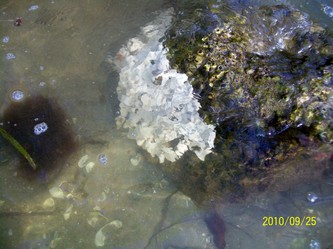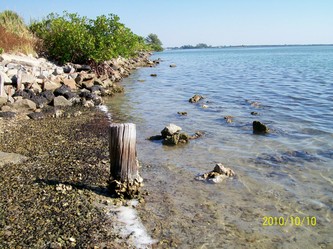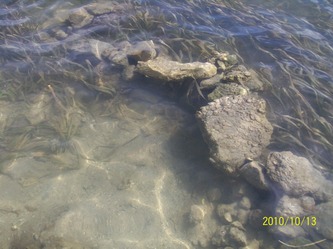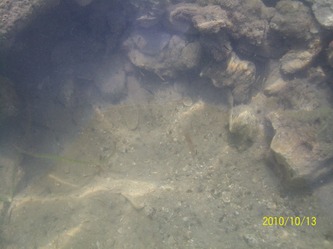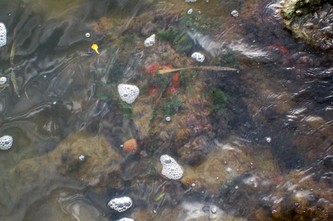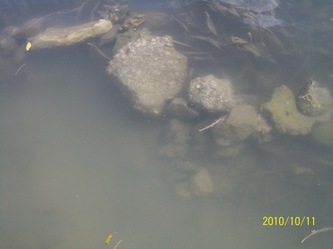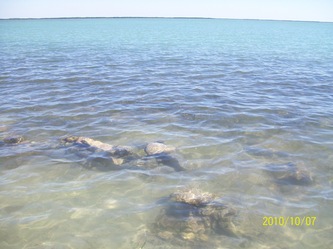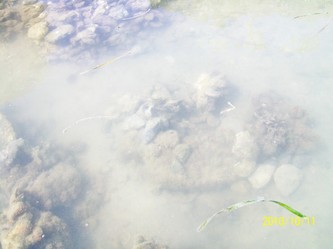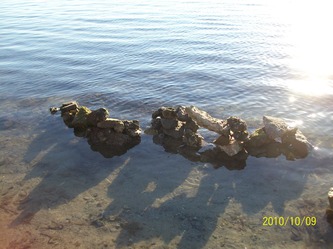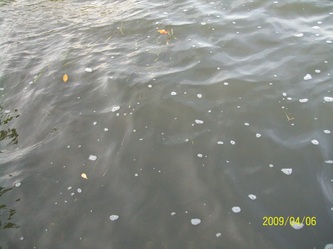Why are we talking about rocks?
When animals of the sea spawn, the tiny new creatures drift in oceans, bays, and waterways with plankton, seaweed, and krill driven by the wind and current carrying them along until they bump into something to which they can attach. Seaweed, driftwood, boats, pilings, mangrove roots, shells, flotsam, litter and rocks offer a potential home where they can mature from larvae to tiny juveniles. Some fertilized eggs, simply sink to the bottom and start life there, but most wash on shore, get consumed, or never find habitat. Five (5)% or so at best, will survive to spawning age (in the wild).
Coral rocks are the best potential home for larval coral attachment, after coral has spawned. It is more difficult for larvae to attach to smooth rock like granite or quartz, but they will try to attach and grow anywhere they can gain purchase, even on unintended substrate like aluminum beverage cans, plastic, or glass bottles. Porous rocks and surfaces, i.e., sandstone, limestone, fossilized corals or shells, cement, and wood are more readily populated by larvae in the seawater column.
When coral rock (composed of calcium carbonate), whole or crushed, was added to our sea garden area(s) water, we used "5 Tests in One Strip, Quick Dip, Aquarium Multi-Test Kit", made by Jungle Laboratories Corporation, Cibolo, Texas 78108-0630, to track and record nitrates, nitrites, alkalinity, and pH. We found that after adding crushed oxidized "shell", pH and alkalinity increased, nitrites and nitrates decreased, and water clarity improved, in addition to increased populations of invertebrate filter feeders, particularly sponges, tunicates and bivalves. More fish appeared at the sites, grazing and foraging, in the sea garden. Dolphins started to frequent the sea garden, as the fish population increased.
If available calcium carbonate in the seawater column is used in making shells, teeth, and bones of animals of the sea, when this balance changes from nutrient overloads (runoff, sewage, die-offs, and algal blooms), does the oceans' pH drop and the ocean become more acidic? Brittle, thin, porous, weak shell formation in the Pacific northwest has been documented in oyster larval spat and blamed on increasing seawater acidity in recent years.
When animals of the sea spawn, the tiny new creatures drift in oceans, bays, and waterways with plankton, seaweed, and krill driven by the wind and current carrying them along until they bump into something to which they can attach. Seaweed, driftwood, boats, pilings, mangrove roots, shells, flotsam, litter and rocks offer a potential home where they can mature from larvae to tiny juveniles. Some fertilized eggs, simply sink to the bottom and start life there, but most wash on shore, get consumed, or never find habitat. Five (5)% or so at best, will survive to spawning age (in the wild).
Coral rocks are the best potential home for larval coral attachment, after coral has spawned. It is more difficult for larvae to attach to smooth rock like granite or quartz, but they will try to attach and grow anywhere they can gain purchase, even on unintended substrate like aluminum beverage cans, plastic, or glass bottles. Porous rocks and surfaces, i.e., sandstone, limestone, fossilized corals or shells, cement, and wood are more readily populated by larvae in the seawater column.
When coral rock (composed of calcium carbonate), whole or crushed, was added to our sea garden area(s) water, we used "5 Tests in One Strip, Quick Dip, Aquarium Multi-Test Kit", made by Jungle Laboratories Corporation, Cibolo, Texas 78108-0630, to track and record nitrates, nitrites, alkalinity, and pH. We found that after adding crushed oxidized "shell", pH and alkalinity increased, nitrites and nitrates decreased, and water clarity improved, in addition to increased populations of invertebrate filter feeders, particularly sponges, tunicates and bivalves. More fish appeared at the sites, grazing and foraging, in the sea garden. Dolphins started to frequent the sea garden, as the fish population increased.
If available calcium carbonate in the seawater column is used in making shells, teeth, and bones of animals of the sea, when this balance changes from nutrient overloads (runoff, sewage, die-offs, and algal blooms), does the oceans' pH drop and the ocean become more acidic? Brittle, thin, porous, weak shell formation in the Pacific northwest has been documented in oyster larval spat and blamed on increasing seawater acidity in recent years.
First (left) picture above, the water carried a heavy load of algae and silt in the current. Algae and silt piled up on new rocks in the path of the current, covering them everyday, for months. It took at least 7 weeks for things to begin to "adjust". I kept adding more rocks and shell everyday. The yellow/tan tint of the water, in addition to the nutrient load in the water column may be eutrophication.
Second picture above, shows how calcium carbonate leaches out of fossilized coral and dissipates into the water, making it cloudy, until it settles. The calcium carbonate seems to elevate pH.
Third picture above, shows new rocks (light in color) that will grow a coating of fresh green fuzzy algae within weeks. Some fish and crabs move into the rocks overnight, finding sanctuary from predators and a place to live, feed, and spawn.
Fourth picture above, again shows, new rocks (light colored) in various formations for nesting and colonization.
Ideas to put calcium back in the ocean
Simply collecting the empty shells (from oysters, clams, conch and mussels) from seafood restaurants, and returning the oyster/clams shells back to the ocean or bay after consuming the animal, could return calcium carbonate into the water column for the next generation of marine life to use, could be a starting point.
Excess nutrients can feed algal blooms, which then overwhelm almost everything else living in the water, at times. Algae, is a part of the big picture for many creatures. Corals, herbivores, filter feeders and bivalves need algae to survive. Thus, algae is good, but when the balance gets disturbed, massive algal blooms can occur.
Besides creating habitat for more life, adding coral rocks or shell to the sea also helps increase biodiversity and biomass. Many plants and animals live in, around, or attach to rocks, to find food, evade predators, grow, make nests, and spawn. Placement of rocks can also increase speed of currents, cause up-welling, or potentially increase oxygenation of water, a very good thing in an hypoxic area. Watch a lazy deceptively calm stream, hit rocks and create turbulent and wild, "white water rapids"; this is an example of a "differential" effect from rocks in the path of a current.
"Bridges" or "ledges" made of rocks cast shadows, cooling seawater underneath them, decreasing thermal stress. Many fish like to stay in shadows. In pictures below, the sea water looks cloudy because the dry, chalky, coral rock was added and is leaching calcium carbonate, into the water column, which soon settles.
After one year the pH was measurably higher in the bay, water clarity improved, and the filter-feeder sponge and invertebrate population, possibly grew quickly because nutrients were high and a more than ample "food supply" existed for them to consume, being part of the reason for the water clarity improving. Using oxidized chalky shell (calcium carbonate) as a planting medium for sea whips, sea fans, and egg masses on sargassum seaweed, also were interconnecting factors.
Click on each picture below for its description.
The white animal encrusting the first rock is not healthy, white usually means dead. It was exposed to air in the intertidal zone landward of the low tide zone, and most likely also got sunburned and suffocated, (it breathes water). Extreme temperatures-- hot or cold (thermal stress) can kill invertebrates, corals and other creatures of the sea, also. Some pictures show shade created by rocks placed in ledge or "bridge" formations.
All rocks used were found high and dry on shore. I chose only fossilized coral. Newly planted rocks have no growth on them and are lighter in color. Rocks that are bright green with algae are a few weeks in the seawater.
I read many books on aquaculture, and have no degree in science, but wanted to share these experiences about planting and hatching things found in sea wrack, and starting sea gardens. Aquaculture textbooks focus on teaching methods and contain information needed to commercially grow marine crops for profit, using brood stock in which their life cycles, breeding, diet, habitat and care for your target "crop".
When things hatched, or grew on their own, and the habitat responded the way it did, it was a complete surprise to me. Hopefully, this experience might be useful to others that wish to try planting a sea garden.
Second picture above, shows how calcium carbonate leaches out of fossilized coral and dissipates into the water, making it cloudy, until it settles. The calcium carbonate seems to elevate pH.
Third picture above, shows new rocks (light in color) that will grow a coating of fresh green fuzzy algae within weeks. Some fish and crabs move into the rocks overnight, finding sanctuary from predators and a place to live, feed, and spawn.
Fourth picture above, again shows, new rocks (light colored) in various formations for nesting and colonization.
Ideas to put calcium back in the ocean
Simply collecting the empty shells (from oysters, clams, conch and mussels) from seafood restaurants, and returning the oyster/clams shells back to the ocean or bay after consuming the animal, could return calcium carbonate into the water column for the next generation of marine life to use, could be a starting point.
Excess nutrients can feed algal blooms, which then overwhelm almost everything else living in the water, at times. Algae, is a part of the big picture for many creatures. Corals, herbivores, filter feeders and bivalves need algae to survive. Thus, algae is good, but when the balance gets disturbed, massive algal blooms can occur.
Besides creating habitat for more life, adding coral rocks or shell to the sea also helps increase biodiversity and biomass. Many plants and animals live in, around, or attach to rocks, to find food, evade predators, grow, make nests, and spawn. Placement of rocks can also increase speed of currents, cause up-welling, or potentially increase oxygenation of water, a very good thing in an hypoxic area. Watch a lazy deceptively calm stream, hit rocks and create turbulent and wild, "white water rapids"; this is an example of a "differential" effect from rocks in the path of a current.
"Bridges" or "ledges" made of rocks cast shadows, cooling seawater underneath them, decreasing thermal stress. Many fish like to stay in shadows. In pictures below, the sea water looks cloudy because the dry, chalky, coral rock was added and is leaching calcium carbonate, into the water column, which soon settles.
After one year the pH was measurably higher in the bay, water clarity improved, and the filter-feeder sponge and invertebrate population, possibly grew quickly because nutrients were high and a more than ample "food supply" existed for them to consume, being part of the reason for the water clarity improving. Using oxidized chalky shell (calcium carbonate) as a planting medium for sea whips, sea fans, and egg masses on sargassum seaweed, also were interconnecting factors.
Click on each picture below for its description.
The white animal encrusting the first rock is not healthy, white usually means dead. It was exposed to air in the intertidal zone landward of the low tide zone, and most likely also got sunburned and suffocated, (it breathes water). Extreme temperatures-- hot or cold (thermal stress) can kill invertebrates, corals and other creatures of the sea, also. Some pictures show shade created by rocks placed in ledge or "bridge" formations.
All rocks used were found high and dry on shore. I chose only fossilized coral. Newly planted rocks have no growth on them and are lighter in color. Rocks that are bright green with algae are a few weeks in the seawater.
I read many books on aquaculture, and have no degree in science, but wanted to share these experiences about planting and hatching things found in sea wrack, and starting sea gardens. Aquaculture textbooks focus on teaching methods and contain information needed to commercially grow marine crops for profit, using brood stock in which their life cycles, breeding, diet, habitat and care for your target "crop".
When things hatched, or grew on their own, and the habitat responded the way it did, it was a complete surprise to me. Hopefully, this experience might be useful to others that wish to try planting a sea garden.
Tides are a major factor in life on earth and very much so in the sea. The middle picture above, shows coral rocks that were underwater during low tide when they were planted. But a week or so later, a much lower tide exposed them to air and they are above water. The same rocks in above center photo are now in second row, center, photo after being moved to deeper water. Now they stay submerged no matter how low the tide gets so the plants, coral, sponges, and other creatures that make this their home will thrive.
In the video, "Successful dessicated horse conch egg sac re-hydration" experiment, duration 6 minutes, you will see where to collect dry egg sacs found on the beach, what they look like, how they were re-hydrated, and actually hatched! Towards the end of the video, you will see tiny orange baby horse conchs about half the size of a small grain of rice. Extremely active, they climbed up the side of the glass and out onto the rim, in vigorous pursuit of life.
In the video, "Successful dessicated horse conch egg sac re-hydration" experiment, duration 6 minutes, you will see where to collect dry egg sacs found on the beach, what they look like, how they were re-hydrated, and actually hatched! Towards the end of the video, you will see tiny orange baby horse conchs about half the size of a small grain of rice. Extremely active, they climbed up the side of the glass and out onto the rim, in vigorous pursuit of life.
Some first attempts at planting: They were completely submerged when planted initially at low tide, until a lower tide occurred. Many things got carried away with the current and were retrieved and replanted. To stop them from being uprooted, I used crushed shell,
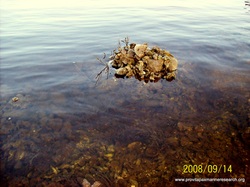
rocks, and oyster shells to re-anchor them more securely. All were moved to deeper water to try to ensure they stayed submerged. The currents also deposited algae, silt and other debris on them, but also helped oxygenate and stimulate them. I had to add crushed shell and rock almost everyday.
One hour after planting:
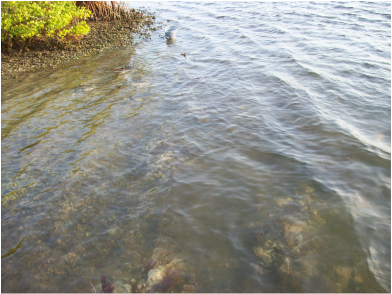
Getting a second chance at life, everything planted was on the beach mixed in with seaweed. Everything you collect potentially breathes seawater, not air like us, and is put in a bucket of seawater for immediate "first aid." Think about it, how long can you hold your breath?
Sponges need to be securely weighted down with rocks until they fully re-hydrate or currents will sweep them on the shore again. Oxidized, dusty sea shell works best as a "potting soil" for re-planting. I always gently squeeze sponges while holding them underwater to expel air and refill them with seawater. Sometimes things get eaten by hungry fish, raccoons, birds and crabs overnight and you just find the nubs or stem of sargassum (seaweed) the next day.
Sponges need to be securely weighted down with rocks until they fully re-hydrate or currents will sweep them on the shore again. Oxidized, dusty sea shell works best as a "potting soil" for re-planting. I always gently squeeze sponges while holding them underwater to expel air and refill them with seawater. Sometimes things get eaten by hungry fish, raccoons, birds and crabs overnight and you just find the nubs or stem of sargassum (seaweed) the next day.
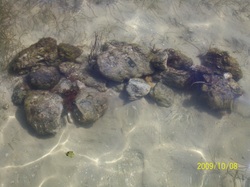
Newly planted sponges (yellow, pink, gray, orange under the rocks) sea whips, (animals), and seaweed with eggs, from the local beach on shore left behind at the high tide line. Try to bury the "root", as if you were planting a tomato plant. Put rocks around the lower part to help it stay in place; currents and waves can knock them down, uproot or carry them away...
Provitapax was given two dedicated tanks at the contained tank system of Gulf Coast Crustacean Research to work with in 2007 and are pictured below. Beached plants, animals and rocks found on shore at the beach were put in these tanks. These pictures are of re-hydrated rocks and plants at up to 6+ weeks.
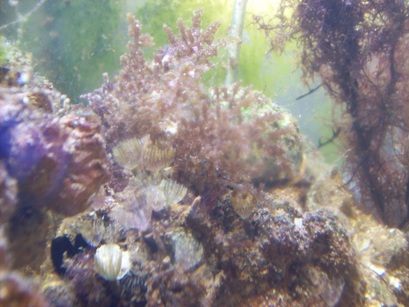
These rocks were found dry and baking in the hot Florida sun on the beach. The seaweed is full of many tiny crustaceans, krill, shrimp and other life, some not visible unless using a microscope.
In the two videos below, BEFORE: "Planted rocks." and AFTER: "Man-made Tidal pool conservation at 2+ years (go to YouTube, Provitapax Marine Research playlist)," are the same site and show what grew and colonized there, subsequent to planting in summer 2009, and May 2012, respectively. Manmade Tidal pools may help stop beach and shoreline erosion...
In the two videos below, BEFORE: "Planted rocks." and AFTER: "Man-made Tidal pool conservation at 2+ years (go to YouTube, Provitapax Marine Research playlist)," are the same site and show what grew and colonized there, subsequent to planting in summer 2009, and May 2012, respectively. Manmade Tidal pools may help stop beach and shoreline erosion...
Simply put, shall we keep taking from finite resources?
Let's put back, give back and plant, in the garden of the sea from which we harvest, to try to help resources exist and renew for the future. Can the ocean keep up with our consumption rate?
In the "Circle of Life", when marine life is harvested before it has reached spawning age, the "circle of life" is broken, cannot renew itself, and biomass diminishes. Marine life must reach maturity and have spawned, to maintain the circle of life, ensuring the next generation of life.
Let's put back, give back and plant, in the garden of the sea from which we harvest, to try to help resources exist and renew for the future. Can the ocean keep up with our consumption rate?
In the "Circle of Life", when marine life is harvested before it has reached spawning age, the "circle of life" is broken, cannot renew itself, and biomass diminishes. Marine life must reach maturity and have spawned, to maintain the circle of life, ensuring the next generation of life.

